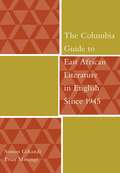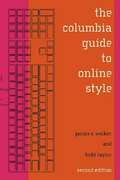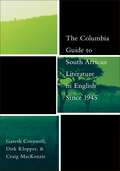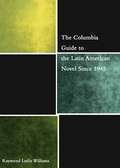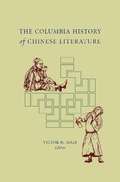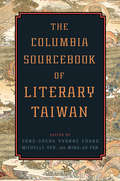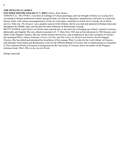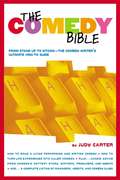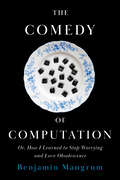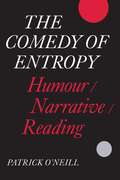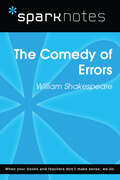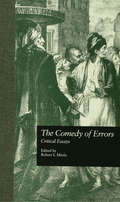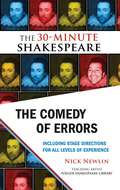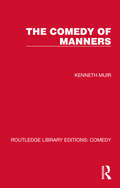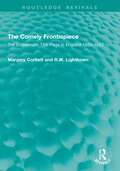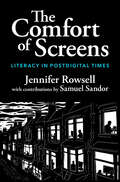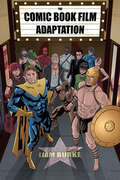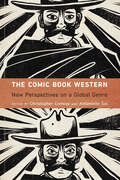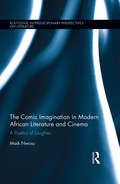- Table View
- List View
The Columbia Guide to East African Literature in English Since 1945 (The Columbia Guides to Literature Since 1945)
by Simon Gikandi Evan MwangiThe Columbia Guide to East African Literature in English Since 1945 challenges the conventional belief that the English-language literary traditions of East Africa are restricted to the former British colonies of Kenya, Uganda, and Tanzania. Instead, these traditions stretch far into such neighboring countries as Somalia and Ethiopia.Simon Gikandi and Evan Mwangi assemble a truly inclusive list of major writers and trends. They begin with a chronology of key historical events and an overview of the emergence and transformation of literary culture in the region. Then they provide an alphabetical list of major writers and brief descriptions of their concerns and achievements. Some of the writers discussed include the Kenyan novelists Grace Ogot and Ngugi wa Thiong'o, Ugandan poet and essayist Taban Lo Liyong, Ethiopian playwright and poet Tsegaye Gabre-Medhin, Tanzanian novelist and diplomat Peter Palangyo, Ethiopian novelist Berhane Mariam Sahle-Sellassie, and the novelist M. G. Vassanji, who portrays the Indian diaspora in Africa, Europe, and North America. Separate entries within this list describe thematic concerns, such as colonialism, decolonization, the black aesthetic, and the language question; the growth of genres like autobiography and popular literature; important movements like cultural nationalism and feminism; and the impact of major forces such as AIDS/HIV, Christian missions, and urbanization. Comprehensive and richly detailed, this guide offers a fresh perspective on the role of East Africa in the development of African and world literature in English and a new understanding of the historical, cultural, and geopolitical boundaries of the region.
The Columbia Guide to Online Style (Columbia Guide To Online Style Ser.)
by Todd Taylor Janice WalkerThe Columbia Guide to Online Style is the standard resource for citing electronic and electronically accessed sources. It is also a critical style guide for creating documents electronically for submission for print or electronic publication. Updated and expanded, this guide now explains how to cite technologies such as Web logs and pod casts; provides more guidance on translating the elements of Columbia Online Style (COS) citations for use with existing print-based formats (such as MLA, APA, and Chicago); and features additional guidelines for producing online and print documents based on new standards of markup language and publication technologies.This edition also includes new bibliographic styles for humanities and scientific projects; examples of footnotes and endnotes for Chicago-style papers; greater detail regarding in-text and parenthetic reference and footnote styles; an added chapter on how to locate and evaluate sources for research in the electronic age; and new examples for citing full-text or full-image articles from online library databases, along with information on how to credit the source of graphics and multimedia files.Staying ahead of rapidly evolving technologies, The Columbia Guide to Online Style continues to be a vital tool for online researchers.
The Columbia Guide to Online Style: Second Edition
by Janice R. Walker Todd TaylorThe Columbia Guide to Online Style is the standard resource for citing electronic and electronically accessed sources. It is also a critical style guide for creating documents electronically for submission for print or electronic publication. Updated and expanded, this guide now explains how to cite technologies such as Web logs and pod casts; provides more guidance on translating the elements of Columbia Online Style (COS) citations for use with existing print-based formats (such as MLA, APA, and Chicago); and features additional guidelines for producing online and print documents based on new standards of markup language and publication technologies. This edition also includes new bibliographic styles for humanities and scientific projects; examples of footnotes and endnotes for Chicago-style papers; greater detail regarding in-text and parenthetic reference and footnote styles; an added chapter on how to locate and evaluate sources for research in the electronic age; and new examples for citing full-text or full-image articles from online library databases, along with information on how to credit the source of graphics and multimedia files. Staying ahead of rapidly evolving technologies, The Columbia Guide to Online Style continues to be a vital tool for online researchers.
The Columbia Guide to South African Literature in English Since 1945 (The Columbia Guides to Literature Since 1945)
by Dirk Klopper Craig Mackenzie Gareth CornwellFrom the outset, South Africa's history has been marked by division and conflict along racial and ethnic lines. From 1948 until 1994, this division was formalized in the National Party's policy of apartheid. Because apartheid intruded on every aspect of private and public life, South African literature was preoccupied with the politics of race and social engineering. Since the release from prison of Nelson Mandela in 1990, South Africa has been a new nation-in-the-making, inspired by a nonracial idealism yet beset by poverty and violence. South African writers have responded in various ways to Njabulo Ndebele's call to "rediscover the ordinary." The result has been a kaleidoscope of texts in which evolving cultural forms and modes of identity are rearticulated and explored.An invaluable guide for general readers as well as scholars of African literary history, this comprehensive text celebrates the multiple traditions and exciting future of the South African voice. Although the South African Constitution of 1994 recognizes no fewer than eleven official languages, English has remained the country's literary lingua franca. This book offers a narrative overview of South African literary production in English from 1945 to the postapartheid present. An introduction identifies the most interesting and noteworthy writing from the period. Alphabetical entries provide accurate and objective information on genres and writers. An appendix lists essential authors published before 1945.
The Columbia Guide to Standard American English
by Kenneth G. WilsonA reliable and entertaining guide to effective writing and speaking for Americans, with some 6,500 concise, alphabetical entries that answer questions about word choice, meanings, pronunciations, spellings, grammatical forms and structures, and idiomatic expressions. Annotation c. by Book News, Inc., Portland, Or.
The Columbia Guide to the Latin American Novel Since 1945
by Raymond. WilliamsIn this expertly crafted, richly detailed guide, Raymond Leslie Williams explores the cultural, political, and historical events that have shaped the Latin American and Caribbean novel since the end of World War II. In addition to works originally composed in English, Williams covers novels written in Spanish, Portuguese, French, Dutch, and Haitian Creole, and traces the profound influence of modernization, revolution, and democratization on the writing of this era. Beginning in 1945, Williams introduces major trends by region, including the Caribbean and U.S. Latino novel, the Mexican and Central American novel, the Andean novel, the Southern Cone novel, and the novel of Brazil. He discusses the rise of the modernist novel in the 1940s, led by Jorge Luis Borges's reaffirmation of the right of invention, and covers the advent of the postmodern generation of the 1990s in Brazil, the Generation of the "Crack" in Mexico, and the McOndo generation in other parts of Latin America. An alphabetical guide offers biographies of authors, coverage of major topics, and brief introductions to individual novels. It also addresses such areas as women's writing, Afro-Latin American writing, and magic realism. The guide's final section includes an annotated bibliography of introductory studies on the Latin American and Caribbean novel, national literary traditions, and the work of individual authors. From early attempts to synthesize postcolonial concerns with modernist aesthetics to the current focus on urban violence and globalization, The Columbia Guide to the Latin American Novel Since 1945 presents a comprehensive, accessible portrait of a thoroughly diverse and complex branch of world literature.
The Columbia Guide to the Latin American Novel Since 1945 (The Columbia Guides to Literature Since 1945)
by Raymond WilliamsIn this expertly crafted, richly detailed guide, Raymond Leslie Williams explores the cultural, political, and historical events that have shaped the Latin American and Caribbean novel since the end of World War II. In addition to works originally composed in English, Williams covers novels written in Spanish, Portuguese, French, Dutch, and Haitian Creole, and traces the profound influence of modernization, revolution, and democratization on the writing of this era.Beginning in 1945, Williams introduces major trends by region, including the Caribbean and U.S. Latino novel, the Mexican and Central American novel, the Andean novel, the Southern Cone novel, and the novel of Brazil. He discusses the rise of the modernist novel in the 1940s, led by Jorge Luis Borges's reaffirmation of the right of invention, and covers the advent of the postmodern generation of the 1990s in Brazil, the Generation of the "Crack" in Mexico, and the McOndo generation in other parts of Latin America. An alphabetical guide offers biographies of authors, coverage of major topics, and brief introductions to individual novels. It also addresses such areas as women's writing, Afro-Latin American writing, and magic realism. The guide's final section includes an annotated bibliography of introductory studies on the Latin American and Caribbean novel, national literary traditions, and the work of individual authors. From early attempts to synthesize postcolonial concerns with modernist aesthetics to the current focus on urban violence and globalization, The Columbia Guide to the Latin American Novel Since 1945 presents a comprehensive, accessible portrait of a thoroughly diverse and complex branch of world literature.
The Columbia History of Chinese Literature
by Ed. Mair Victor H.The Columbia History of Chinese Literature is a comprehensive yet portable guide to China's vast literary traditions. Stretching from earliest times to the present, the text features original contributions by leading specialists working in all genres and periods. Chapters cover poetry, prose, fiction, and drama, and consider such contextual subjects as popular culture, the impact of religion, the role of women, and China's relationship with non-Sinitic languages and peoples. Opening with a major section on the linguistic and intellectual foundations of Chinese literature, the anthology traces the development of forms and movements over time, along with critical trends, and pays particular attention to the premodern canon.
The Columbia History of Chinese Literature
by Victor H. MairThe Columbia History of Chinese Literatureis a comprehensive yet portable guide to China's vast literary traditions. Stretching from earliest times to the present, the text features original contributions by leading specialists working in all genres and periods. Chapters cover poetry, prose, fiction, and drama, and consider such contextual subjects as popular culture, the impact of religion, the role of women, and China's relationship with non-Sinitic languages and peoples. Opening with a major section on the linguistic and intellectual foundations of Chinese literature, the anthology traces the development of forms and movements over time, along with critical trends, and pays particular attention to the premodern canon.
The Columbia Sourcebook of Literary Taiwan
by Michelle Chang Yeh Sung-Sheng Yvonne Fan Ming-JuContains more than 160 documents and writings that reflect the development of Taiwanese literature from the early modern period to the twenty-first century
The Columbia Sourcebook of Literary Taiwan
by Michelle Chang Yeh Sung-Sheng Yvonne Fan Ming-JuThis sourcebook contains more than 160 documents and writings that reflect the development of Taiwanese literature from the early modern period to the twenty-first century. Selections include seminal essays in literary debates, polemics, and other landmark events; interviews, diaries, and letters by major authors; critical and retrospective essays by influential writers, editors, and scholars; transcripts of historical speeches and conferences; literary-society manifestos and inaugural journal prefaces; and governmental policy pronouncements that have significantly influenced Taiwanese literature. These texts illuminate Asia's experience with modernization, colonialism, and postcolonialism; the character of Taiwan's Cold War and post–Cold War cultural production; gender and environmental issues; indigenous movements; and the changes and challenges of the digital revolution. Taiwan's complex history with Dutch, Spanish, and Japanese colonization; strategic geopolitical position vis-à-vis China, Japan, and the United States; and status as a hub for the East-bound circulation of technological and popular-culture trends make the nation an excellent case study for a richer understanding of East Asian and modern global relations.
The Columbia Sourcebook of Literary Taiwan
by Michelle Yeh Sung-sheng Yvonne Chang Ming-Ju FanThis sourcebook contains more than 160 documents and writings that reflect the development of Taiwanese literature from the early modern period to the twenty-first century. Selections include seminal essays in literary debates, polemics, and other landmark events; interviews, diaries, and letters by major authors; critical and retrospective essays by influential writers, editors, and scholars; transcripts of historical speeches and conferences; literary-society manifestos and inaugural journal prefaces; and governmental policy pronouncements that have significantly influenced Taiwanese literature.These texts illuminate Asia's experience with modernization, colonialism, and postcolonialism; the character of Taiwan's Cold War and post--Cold War cultural production; gender and environmental issues; indigenous movements; and the changes and challenges of the digital revolution. Taiwan's complex history with Dutch, Spanish, and Japanese colonization; strategic geopolitical position vis-à-vis China, Japan, and the United States; and status as a hub for the East-bound circulation of technological and popular-culture trends make the nation an excellent case study for a richer understanding of East Asian and modern global relations.
The Comedies
by Terence Betty RadiceThe Roman dramatist Terence (c. 186-159 BC) adapted many of his comedies from Greek sources, rendering them suitable for audiences of his own time by introducing subtler characterization and more complex plots. <p><p>In his romantic play, The Girl from Andros, Terence portrays a love affair saved by a startling discovery. The Self-Tormentor focusses on a man's remorse after sending his son to war, and The Eunuch depicts a case of mistaken identity. Phormio is as rich in intrigue as a French farce, while The Mother-in-Law shows two families striving to save a marriage and The Brothers contrasts strict and lenient upbringings. <p><p>With their tight plots and spare dialogue, Terence gave his plays a sense of humanity that became a model in the Renaissance and greatly influenced Molière.
The Comedy Bible: From Stand-up to Sitcom--the Comedy Writer's Ultimate "How To" Guide
by Judy CarterDo you think you're funny? Do you want to turn your sense of humor into a career? If the answer is yes, then Judy Carter's The Comedy Bible is for you. The guru to aspiring stand-up comics provides the complete scoop on being -- and writing -- funny for money. If you've got a sense of humor, you can learn to make a career out of comedy, says Judy Carter. Whether it's creating a killer stand-up act, writing a spec sitcom, or providing jokes for radio or one-liners for greeting cards, Carter provides step-by-step instructions in The Comedy Bible. She helps readers first determine which genre of comedy writing or performing suits them best and then directs them in developing, refining, and selling their work. Using the hands-on workbook format that was so effective in her bestselling first book, Stand-Up Comedy: The Book, Carter offers a series of day-by-day exercises that draw on her many years as a successful stand-up comic and the head of a nationally known comedy school. Also included are practical tips and advice from today's top comedy professionals -- from Bernie Brillstein to Christopher Titus to Richard Lewis. She presents the pros and cons of the various comedy fields -- stand-up, script, speech and joke writing, one-person shows, humor essays -- and shows how to tailor your material for each. She teaches how to find your "authentic" voice -- the true source of comedy. And, perhaps most important, Carter explains how to take a finished product to the next level -- making money -- by pitching it to a buyer and negotiating a contract. Written in Carter's unique, take-no-prisoners voice, The Comedy Bible is practical, inspirational, and funny.
The Comedy of Computation: Or, How I Learned to Stop Worrying and Love Obsolescence
by Benjamin MangrumIn this cultural history of the computer, Benjamin Mangrum shows that comedy has been central to how we've made sense of the technology's sweeping effects on public life and private experience. From the first Broadway play to include a computer in the 1950s to popular films like You've Got Mail and joke-telling digital assistants, Mangrum assembles an extensive archive of work by writers, filmmakers, programmers, engineers, and other technologists who have coupled comedy with computation. Many have used comedy to make the computer seem ordinary. Others have tried to stage the assimilation of computers within corporate life as a kind of comic drama. Mangrum describes these and many other ways in which comedy and computation have come together as a new genre of experience: the comedy of computation. The modern world exalts advances in technology, but we are constantly haunted by the specter of falling behind and becoming obsolete. Mangrum examines how comedy serves as a stage for working out these conflicted modes of experience in writing by Dave Eggers, Curtis Sittenfeld, Ishmael Reed, and Kurt Vonnegut Jr., among others, arguing that when we look at the comic forms that shape the cultures of computing, we come to better understand the tensions and contradictions internal to the social world we inhabit.
The Comedy of Entropy: Humour/Narrative/Reading (The Royal Society of Canada Special Publications)
by Patrick O'NeillEntropic comedy is the phrase coined by Patrick O'Neill in this study to identify a particular mode of twentieth-century narrative that is not generally recognized. He describes it as the narrative expression of forms of decentred humour, or what might more loosely be called 'black humour.'O'Neill begins his investigation by examining the rise of an essentially new form of humour over the last three hundred years or so in the context of a rapid decay of confidence in traditional authoritative value systems. O'Neill analyses the resulting reorganization of the spectrum of humour, and examines th implications of this for the ways in which we read texts and the world we live in.He then turns from intellectual history to narratology and considers the relationship, in theoretical terms, of homour, play, and narrative as systems of discourse and the role of the reader as a textualizing agent.Finally, he considers some dozen twentieth-century narratives in French, German, and English (with occasional reference to other literatures) in the context of those historical and theoretical concerns. Authors of the texts analysed include Céline, Camus, Satre, and Robbe-Grillet in French; Heller, Beckett, Pynchon, Nabokov, and Joyce in English; Grass, Kafka, and Handke in German. The analyses proceed along lines suggested by structuralist, semiotic, and post-structuraist narrative and literary theory. From his analyses of these works O'Neill concludes they illustrate in narrative terms a mode of modern writing definable as entropic comedy, and he develops a taxonomy of the mode.
The Comedy of Errors (SparkNotes Literature Guide Series)
by SparkNotesThe Comedy of Errors (SparkNotes Literature Guide) by William Shakespeare Making the reading experience fun! Created by Harvard students for students everywhere, SparkNotes is a new breed of study guide: smarter, better, faster.Geared to what today's students need to know, SparkNotes provides:chapter-by-chapter analysis explanations of key themes, motifs, and symbols a review quiz and essay topics Lively and accessible, these guides are perfect for late-night studying and writing papers.
The Comedy of Errors: Critical Essays (Shakespeare Criticism)
by Robert S. MiolaThis collection of essays and reviews represents the most significant and comprehensive writing on Shakespeare's A Comedy of Errors. Miola's edited work also features a comprehensive critical history, coupled with a full bibliography and photographs of major productions of the play from around the world. In the collection, there are five previously unpublished essays. The topics covered in these new essays are women in the play, the play's debt to contemporary theater, its critical and performance histories in Germany and Japan, the metrical variety of the play, and the distinctly modern perspective on the play as containing dark and disturbing elements. To compliment these new essays, the collection features significant scholarship and commentary on The Comedy of Errors that is published in obscure and difficulty accessible journals, newspapers, and other sources. This collection brings together these essays for the first time.
The Comedy of Errors: The 30-Minute Shakespeare
by Nick NewlinThe Comedy of Errors: The 30-Minute Shakespeare offers five raucous scenes from this extravaganza of mistaken identity.The abridgement begins with a dramatic physical enactment of the twins' separation at sea. The play continues with a series of foibles featuring Antipholus of Ephesus, Dromio of Ephesus, and their identical twin counterparts from Antipholus.Adriana and Luciana receive hysterically misguided attention from the twins. Emilia and Egeon as the long-lost parents, and the riotous conjurer Dr. Pinch round out the cast of characters in Shakespeare's most uproarious comedy.The edition includes a preface by Nick Newlin containing helpful advice on how to put on a Shakespeare performance in a high school class with novice actors, as well as an appendix with suggestions for the specific play and recommendations for further resources.
The Comedy of Manners (Routledge Library Editions: Comedy)
by Kenneth MuirOriginally published in 1970, this title starts with an introduction, in which Professor Muir distinguishes between the Comedy of Manners and other types of comedy and traces its origins in English and French literature, there are then chapters on the major writers – Etherege, Dryden, Wycherly, Congreve, Vanbrugh, Farquhar – and on Jeremy Collier’s attack on the immorality and profaneness of the plays. This is followed by a discussion of the reasons for the decline of comedy in the eighteenth century and an account of its revival by Sheridan and, belatedly, by Wilde. Professor Muir takes issue with a number of recent critics on the dramatic value of the plays.
The Comely Frontispiece: The Emblematic Title-Page in England 1550–1660 (Routledge Revivals)
by Margery Corbett R.W. LightbownMany of the major books published in the years between 1550 and 1660 – one of the richest periods in English culture – were embellished with an elaborate engraved title-page. The Comely Frontispiece (1979) selects twenty such title-pages which represent the different branches of learning – theology, philosophy, history, poetry, medicine – and explains that these pages were not mere ornaments but visual epitomes in the emblematic mode of significant aspects of the book. They were designed by the author and explore the whole world of Renaissance emblematic imagery on which they drew. We see how famous figures used the engraved title-page to express the ideas they had in mind when their books were conceived and written – ideas about the Church and society, philosophy and manners, poetry and drama, science and medicine – so that it affords us an exceptional insight into what they themselves considered was important or attractive in their own creations.
The Comfort of Screens: Literacy in Postdigital Times
by Jennifer RowsellAre screens the modern mirrors of the soul? The postdigital condition blurs the line between screens, humans, physical contexts, virtual worlds, analogue texts, and time as linear and lockstep. This book presents a unique study into people and their screen lives, giving readers an original perspective on digital literacies and communication in an ever-changing and capaciously connected world. Seventeen individuals who all live on the same crescent, aged from 23 to 84, share their thoughts, habits, and ruminations on screen lives, illuminating eclectic, complex, and dynamic insights about life in a postdigital age. Their stories are brought to life through theory, interview excerpts, song lyrics, and woodcut illustrations. Breaking free from digital literacy as a separate, discrete skill to one that should be taught as it is lived – especially as automation, AI, and algorithms encroach into our everyday lives – this fascinating book pulls readers into the future of digital education.
The Comic Book Film Adaptation: Exploring Modern Hollywood's Leading Genre
by Liam BurkeIn the summer of 2000 X-Men surpassed all box office expectations and ushered in an era of unprecedented production of comic book film adaptations. This trend, now in its second decade, has blossomed into Hollywood's leading genre. From superheroes to Spartan warriors, The Comic Book Film Adaptation offers the first dedicated study to examine how comic books moved from the fringes of popular culture to the center of mainstream film production.Through in-depth analysis, industry interviews, and audience research, this book charts the cause-and-effect of this influential trend. It considers the cultural traumas, business demands, and digital possibilities that Hollywood faced at the dawn of the twenty-first century. The industry managed to meet these challenges by exploiting comics and their existing audiences. However, studios were caught off-guard when these comic book fans, empowered by digital media, began to influence the success of these adaptations. Nonetheless, filmmakers soon developed strategies to take advantage of this intense fanbase, while codifying the trend into a more lucrative genre, the comic book movie, which appealed to an even wider audience. Central to this vibrant trend is a comic aesthetic in which filmmakers utilize digital filmmaking technologies to engage with the language and conventions of comics like never before.The Comic Book Film Adaptation explores this unique moment in which cinema is stimulated, challenged, and enriched by the once-dismissed medium of comics.
The Comic Book Western: New Perspectives on a Global Genre (Postwestern Horizons)
by Christopher Conway Antoinette SolOne of the greatest untold stories about the globalization of the Western is the key role of comics. Few American cultural exports have been as successful globally as the Western, a phenomenon commonly attributed to the widespread circulation of fiction, film, and television. The Comic Book Western centers comics in the Western&’s international success. Even as readers consumed translations of American comic book Westerns, they fell in love with local ones that became national or international sensations. These essays reveal the unexpected cross-pollinations that allowed the Western to emerge from and speak to a wide range of historical and cultural contexts, including Spanish and Italian fascism, Polish historical memory, the ideology of shōjo manga from Japan, British post-apocalypticism and the gothic, race and identity in Canada, Mexican gender politics, French critiques of manifest destiny, and gaucho nationalism in Argentina. The vibrant themes uncovered in The Comic Book Western teach us that international comic book Westerns are not hollow imitations but complex and aesthetically powerful statements about identity, culture, and politics.
The Comic Imagination in Modern African Literature and Cinema: A Poetics of Laughter (Routledge Interdisciplinary Perspectives on Literature)
by Maik NwosuThis book is a seminal study that significantly expands the interdisciplinary discourse on African literature and cinema by exploring Africa’s under-visited carnivalesque poetics of laughter. Focusing on modern African literature as well as contemporary African cinema, particularly the direct-to-video Nigerian film industry known as Nollywood, the book examines the often-neglected aesthetics of the African comic imagination. In modern African literature, which sometimes creatively traces a path back to African folklore, and in Nollywood — with its aesthetic relationship to Onitsha Market Literature — the pertinent styles range from comic simplicitas to comic magnitude with the facilitation of language, characterization, and plot by a poetics of laughter or lightness as an important aspect of style. The poetics at work is substantially carnivalesque, a comic preference or tendency that is attributable, in different contexts, to a purposeful comic sensibility or an unstructured but ingrained or virtual comic mode. In the best instances of this comic vision, the characteristic laughter or lightness can facilitate a revaluation or reappreciation of the world, either because of the aesthetic structure of signification or the consequent chain of signification. This referentiality or progressive signification is an important aspect of the poetics of laughter as the African comic imagination variously reflects, across genres, both the festival character of comedy and its pedagogical value. This book marks an important contribution to African literature, postcolonial literature, world literature, comic imagination, poetics, critical theory, and African cinema.
